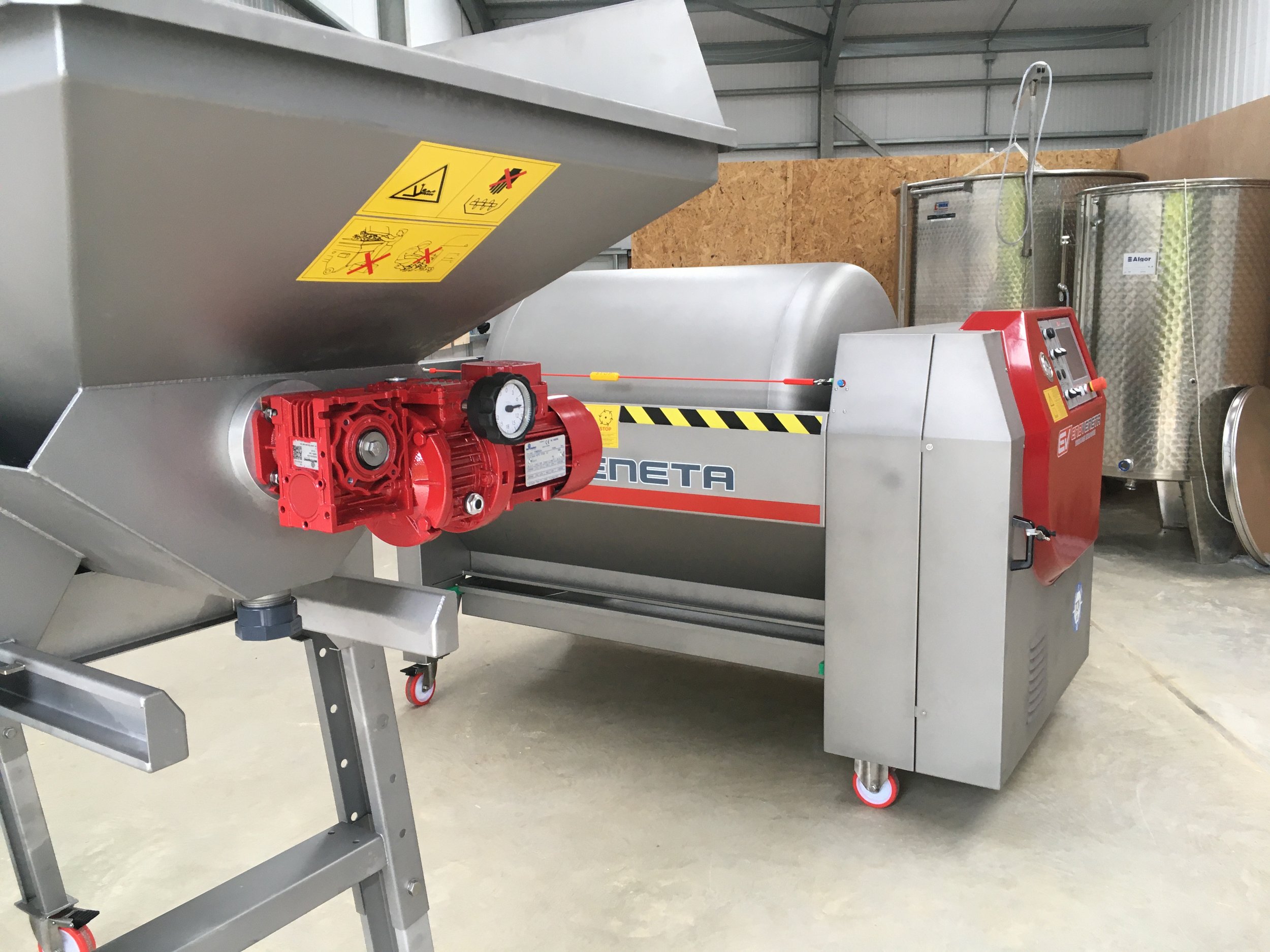Pressing Matters - choosing the kit.
This chapter has been a long time coming - I bough the equipment over a year ago and have only now sat down to write about it. However the year’s worth of use has meant that I have a slightly different perspective on the kit, it having been used for two harvests, so the wait may be of some value.
First confession - I am a bit of a kit junky. I enjoy the research, the understanding of processes, and eventually the materiality of the ‘things’. So on one level setting-up the winery was a joy. Kit of course is not the be all-and end-all, great fruit and thoughtful winemaking decisions are paramount. I had the former covered in the selection of vineyards, and the latter by my consultant - so I could at least ensure we were using the most suitable equipment for the job.
At my scale (15 tonnes a year) I sit somewhere between a hobbyist with grand ideas and a commercial winery, so on the one hand one is looking at ‘garage winemaker’ kit, but if one turns to the small scale professional equipment costs leap skyward.
Press and destemmer - the heart of the winery! The press is the most expensive single piece of kit in my winery, and is only used a few times a year! The pound / hours are horrendous. I finally chose a small pneumatic press - a steel drum in which a compressor inflates a diaphragm to variable pressures, pressing the grapes against the perforated sides of the drum, through which juice flows down into a tray below. The drum can rotate, mixing-up the mass of fruit. Some argue that a basket press (see below) is more gentle, but a well engineered pneumatic press with computer controlled pressing cycles can emulate the gentleness of a basket press while offering the advantages of efficiency, and an ability to use the press to simply rotate the gape mass and obtain free run juice without exerting any pressure - acting more like a drain than a press, and collecting very high quality juice. We opted for an ‘open press’, which is to say the cylinder’s perforations are exposed to the air. A closed press - which is more expensive - contains the perforations in an airtight jacket, allowing inert gas to blanket the flowing juice. The nature of English wines in general (their high acidity protecting them), and the wines we are making specifically, meant that we did not need to be quite so particular. An open press is much easier to clean. The press can be operated on preprogrammed cycles, or selecting every operation manually, or indeed a combination of the two.
To partner this I selected a destemmer (which separates berries from stems) with all the ‘gentleness’ options: a plastic rather than steel cylinder so as not to cut the grapes, variable speed, and silicon tipped beaters. We do not crush the grapes between destemming and pressing, instead pressing the whole fruit (or in some cases whole bunches). This provides lower yields of juice, but higher quality. In the majority of English wine making process one wants the facility to avoid excessive contact between juice/ pulp and broken skins. The grapes then slide down a chute from the destemmer to the press, again making gentle handling a priority.
The choice of these two items also meant that 3 phase electricity was a must.
In retrospect I’m happy with these choices, but with the following caveats.
1). I bought a small press, capable of handling a scant tonne of uncrushed fruit, or half a tonne of whole bunches. My production quantities means that I sometimes receive 3 tonnes of fruit at a time, which is at least 3 press cycles. This can be eight or nine hours of work, ending in the early hours of the morning with grotty cleaning still to do. Had I the funds I think i’d have opted for a slightly larger press to reduce processing time; not too much larger, or the smaller consignments of 1 tonne would be a problem.
2). The press has quite a small hatch, which make it tricky to tip baskets straight-in. Most of the time baskets are tipped in to the destemmer first, which has a good sized hopper, but if we want to process whole bunches straight from the baskets then the small hatch creates extra handling.
3) The absence of a crusher, and using gentle press cycles leads to excellent quality juice, but in much lower volumes than most wineries calculate on. Typically I get around 500 - 600L a tonne in total (depending on the press cycle chosen) - far less than the commonly supposed 650 - 700L - and hence the wine costs more per litre to make / sell.
4). The destemmer works extremely well, and I’m very happy using a custom fabricated ‘gravity powered’ chute (rather than pump) to move the fruit from destemmer to press.
Other Options
For a smaller winery a hydropress might be worth consideration. This operates on a similar principle but instead of using a compressor and vacuum pump to inflate / deflate a diaphragm it uses mains water to pressurise a bladder nestled in a perforated cylinder. The grapes are put in the cylinder and the bladder filled with water, pressing the grapes against the side. These are smaller, the largest I saw was about 500l capacity - far less than half a tonne of fruit - and one assumes the pressure is limited by your water supply. They are more affordable than a pneumatic press however.
A basket press has a perforated steel or wood-slat basket into which the fruit it tipped, then a plate is placed on top and squeezed down, either by a screw mechanism or pneumatics - juice flows into a tray below. They have many followers and are very traditional. Their costs vary tremendously from a few £100 to many 10s of thousands depending on size and technology. They can be messy to use and are not best suited to the wines I was intending to make.
The watchword throughout has been ‘gentle’, but that has to be tempered with the practicality of running multiple cycles of small quantities of fruit (and therefore multiple cleaning cycles) and an ease of use, both operationally and practically.
Details.
Press: Enoveneta PPA9
Destemmer: Enoveneta TOP5 with optional polypropylene cylinder.
Modifications: steel chute to feed from destemmer to press (not pump) and we modified the press tray to put the sump on the bottom (not front wall) and also put it on casters to protect the lower sump and make it move flexible.
Bought from their UK agents, Vigo Ltd.


